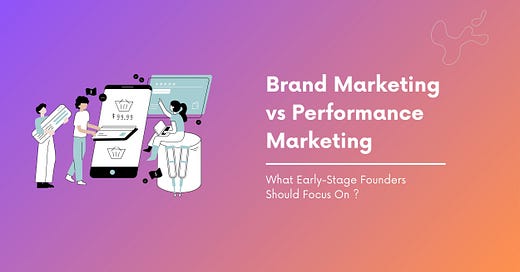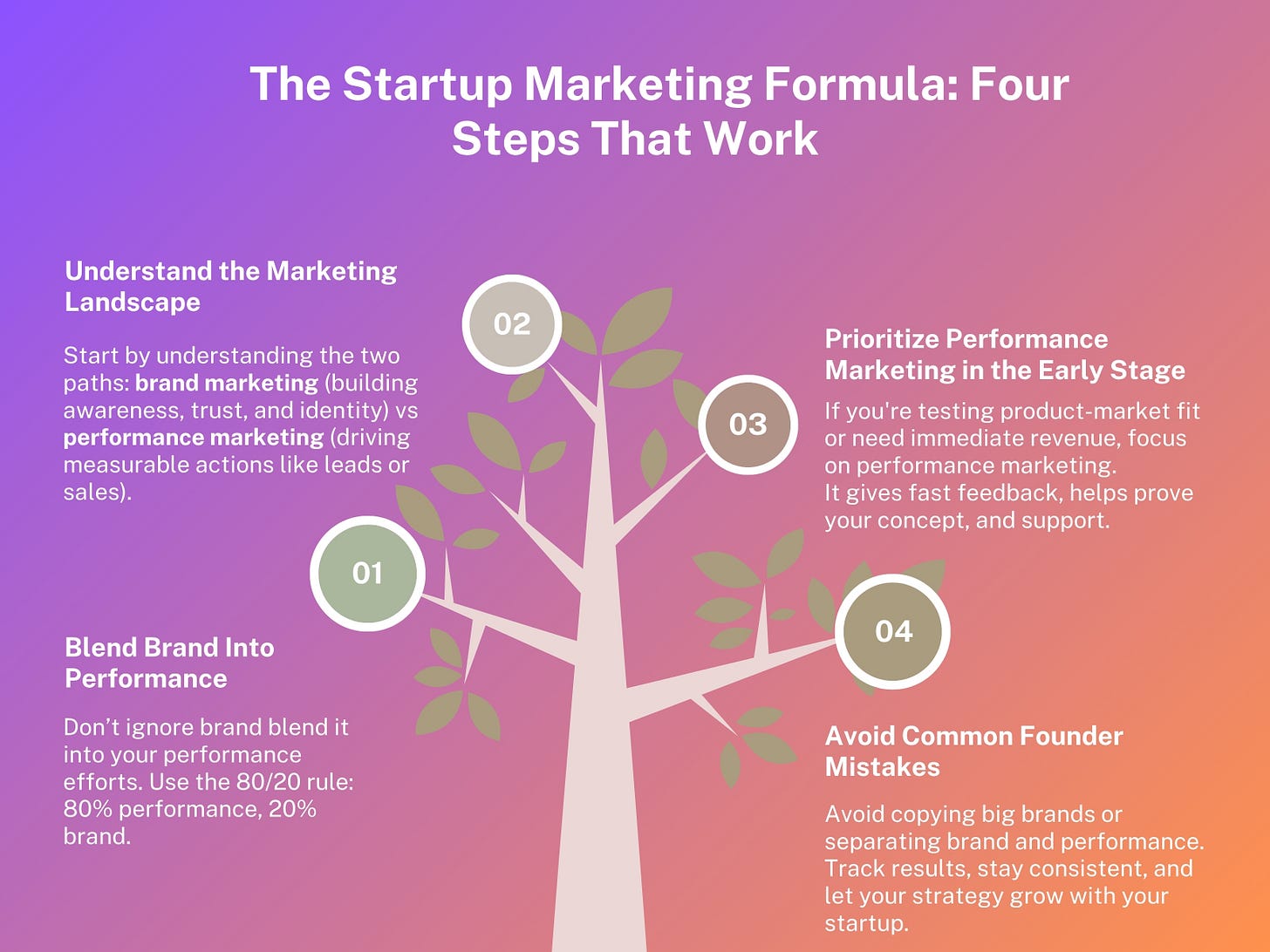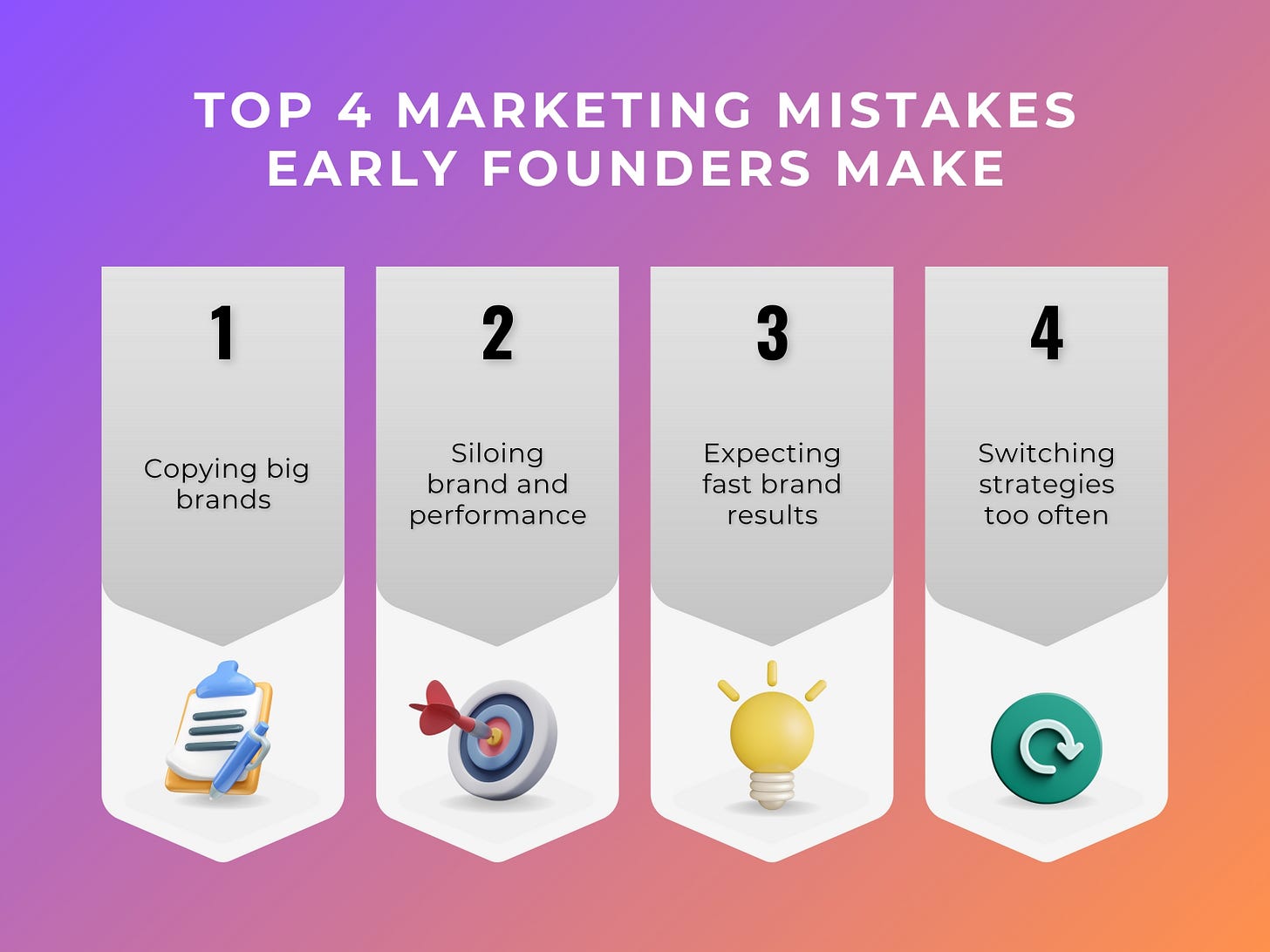Brand Marketing Vs Performance Marketing: What Early-Stage Founders Should Focus On
A Tactical Guide to Balancing Brand and Performance on a Startup Budget
As an early-stage founder, you're constantly making tough decisions about where to invest your limited resources. One of the most critical choices you'll face is how to allocate your marketing budget between brand marketing and performance marketing. This decision can make or break your startup's growth trajectory.
The marketing landscape offers two distinct paths: building long-term brand equity or driving immediate, measurable results. While established companies can afford to do both, startups must choose wisely. The wrong choice can drain your runway without delivering the growth you desperately need.
What is brand marketing vs performance marketing?
Brand marketing focuses on building awareness, emotional connection, and long-term customer relationships. It's about telling your story, establishing your company's personality, and creating mental availability in your target market. Brand marketing investments include content marketing, PR, sponsorships, brand advertising, and thought leadership initiatives.
Performance marketing, on the other hand, is all about driving immediate, measurable actions. Every dollar spent is tied to a specific outcome: clicks, leads, conversions, or sales. Performance marketing channels include paid search, social media advertising, affiliate marketing, email campaigns, and conversion optimization.
Brand Marketing vs Performance Marketing: Key Differences
Why early-stage founders struggle with this decision
Early-stage founders face a unique set of constraints that make this decision particularly challenging.
Limited runway creates urgency.
Investor expectations compound the pressure.
Resource constraints limit execution quality.
Market uncertainty makes long-term planning difficult.
Limited runway creates urgency. Most startups have 12-18 months of funding to prove their concept and secure the next round. Every marketing dollar must contribute to survival and growth. This creates a natural bias toward performance marketing, which promises immediate returns and measurable results.
Investor expectations compound the pressure. VCs and angel investors want to see clear metrics: monthly recurring revenue, customer acquisition costs, and growth rates. Brand metrics like awareness and sentiment are harder to quantify and don't directly correlate with business outcomes in the short term.
Resource constraints limit execution quality. Brand marketing requires consistent investment over time to build meaningful awareness. A small, inconsistent brand budget often produces minimal impact, leading founders to question whether brand marketing is worth pursuing at all.
Market uncertainty makes long-term planning difficult. Early-stage companies are still discovering their ideal customer profile, refining their value proposition, and iterating on their product. Investing in brand marketing before achieving product-market fit can feel premature and wasteful.
When to prioritize performance marketing over brand marketing
For most early-stage founders, performance marketing should be the primary focus during the initial growth phases.
Start with performance marketing if you need immediate proof of concept. When you're testing product-market fit, performance marketing provides the fastest feedback loop. You can quickly identify which messages resonate, which channels convert, and which customer segments respond best to your offering.
Prioritize performance marketing when cash flow is critical. If your startup needs to generate revenue quickly to extend runway or achieve profitability, performance marketing delivers measurable results that directly impact your bottom line. Every campaign can be optimized for immediate return on investment.
Focus on performance marketing when your market is well-defined. If you're entering a category with established customer behavior and clear intent signals, performance marketing can efficiently capture existing demand. Search advertising, for example, works well when people are already looking for solutions like yours.
Choose performance marketing for direct-to-consumer models. B2C startups, particularly e-commerce businesses, often benefit from performance marketing's ability to drive immediate purchases. The short sales cycles and lower consideration requirements make performance marketing highly effective.
The key advantage of starting with performance marketing is learning speed. You'll quickly discover what works, optimize your customer acquisition engine, and build a foundation of paying customers. This data becomes invaluable for future marketing decisions and fundraising conversations.
How to balance both approaches with limited budgets
While performance marketing should typically dominate early-stage marketing budgets, completely ignoring brand building can hurt long-term growth potential.
Adopt a performance-first, brand-conscious approach
Leverage content marketing as a bridge strategy
Use organic social media for brand building
Consider the 80/20 rule for budget allocation
Focus on brand consistency within performance campaigns
Adopt a performance-first, brand-conscious approach. Structure your campaigns to drive immediate results while building brand awareness as a secondary benefit. For example, create compelling ad creative that showcases your brand personality while optimizing for conversions. Write email campaigns that build relationships while driving sales.
Leverage content marketing as a bridge strategy. High-quality content serves both performance and brand objectives. SEO-optimized blog posts drive organic traffic and leads while establishing thought leadership. Case studies generate social proof for immediate conversions while building long-term credibility.
Use organic social media for brand building. While paid social should focus on performance, your organic presence can build brand awareness cost-effectively. Share behind-the-scenes content, company culture, and founder stories to humanize your brand without significant budget allocation.
Consider the 80/20 rule for budget allocation. Many successful early-stage companies allocate 80% of their marketing budget to performance marketing and 20% to brand-building activities. This ensures immediate growth while making small investments in long-term brand equity.
Focus on brand consistency within performance campaigns. Even when optimizing for conversions, maintain consistent messaging, visual identity, and brand voice across all channels. This creates brand recognition without additional budget allocation.
Common mistakes founders make (and how to avoid them)
Many founders make critical errors when navigating the brand versus performance marketing decision. Understanding these pitfalls can save you time, money, and missed opportunities.
Mistake #1Copying what established companies do.
Many founders see successful brands investing heavily in brand marketing and assume they should do the same. However, established companies have different constraints, goals, and resources. What works for a Fortune 500 company rarely translates to early-stage startups.
Mistake #2 Treating brand and performance marketing as completely separate.
Some founders create isolated brand campaigns that don't contribute to business growth, or performance campaigns that ignore brand building entirely. This binary thinking wastes opportunities and resources.
Mistake #3 Expecting immediate results from brand marketing.
Brand marketing works over months and years, not days and weeks. Founders who invest in brand marketing and expect quick returns often abandon effective strategies prematurely.
Mistake #4 Switching strategies too frequently.
The pressure to show results quickly leads some founders to constantly change their marketing approach. This prevents any strategy from reaching its full potential and creates inconsistent brand experiences.
Brand Marketing vs Performance Marketing FAQ
Q: How much should early-stage startups spend on brand marketing?
Most early-stage startups should allocate 10-20% of their marketing budget to brand-building activities, with the remaining 80-90% focused on performance marketing. However, this can vary based on your industry, business model, and growth stage.
Q: Can content marketing serve both brand and performance objectives?
Content marketing is one of the most effective ways to build brand awareness while driving immediate results. SEO-optimized content can generate leads while establishing thought leadership. Case studies build social proof while showcasing your brand values.
Q: What metrics should I track for brand marketing efforts?
Key brand metrics include website traffic from branded searches, social media engagement rates, email open rates, brand mention volume, and customer feedback sentiment. These leading indicators can predict future business performance.
Q: Should B2B startups approach this differently than B2C?
B2B startups often benefit from incorporating brand elements earlier because longer sales cycles and relationship-based selling make trust and credibility crucial. However, performance marketing should still dominate the budget allocation.







